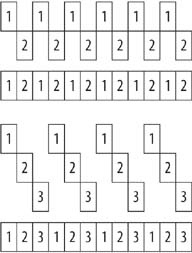Multiangle Video
We've seen several examples now of multiple audio tracks in use. You can do the same with video tracks. However, this requires a lot more effort—both on the production side (creating two hours of video is much more work than creating one hour) and on the DVD playback side. Because of that, you'll have to keep some restrictions in mind.
Multiangle video restrictions
To understand why you have restrictions on the content used for multiangle video, it helps to understand how the video is laid down on the disc. Frames from each angle of a multiangle clip are interleaved on the disc. Figure 6-9 shows an example of three clips as they logically would appear on the disc.

Figure 6-9. Two- and three-angle streams shown individually and interlaced
Because of this interleaving, you have two big restrictions on your video clips:
They have to use the same bit rate—and this means VBR encoding is out.
They have to obey throughput limits:
—2–5 angles: ~8Mbps max per clip —6–8 angles: ~7.5Mbps max per clip —9 angles: ~7Mbps max per clip
And, of course, these clips take up space, so unless you use a really low bit rate, you won't be able to have 5 angles in your 100-minute feature film.
Multiangle uses
Some of the most effective uses of multiangle video are for instructional purposes. One cool use in the world of special-edition DVDs comes from showing the construction of complex, composited ...
Get DVD Studio Pro 3: In the Studio now with the O’Reilly learning platform.
O’Reilly members experience books, live events, courses curated by job role, and more from O’Reilly and nearly 200 top publishers.

